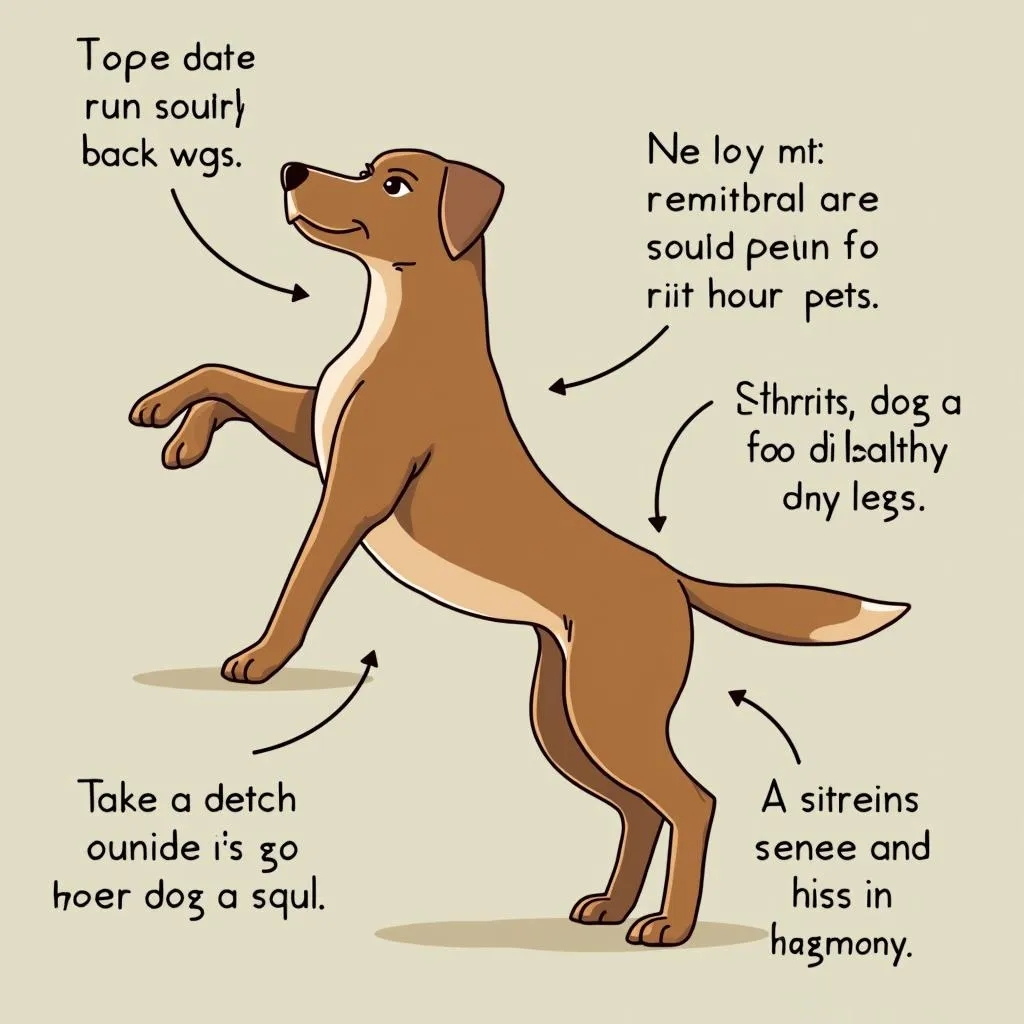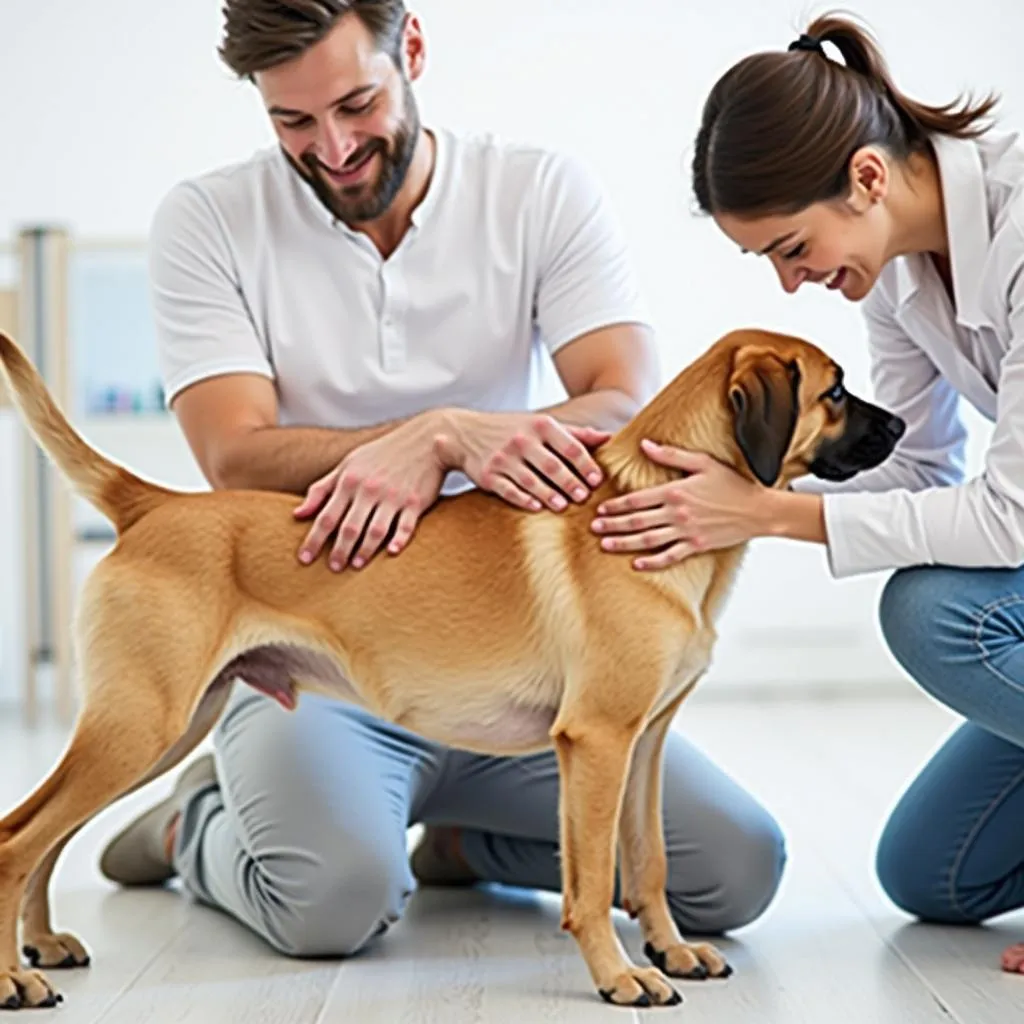“Con chó nhà tôi cứ hay bị đau chân sau, có phải nó bị bệnh gì không?”. This is a common concern for many pet owners. Dogs are our furry companions, and seeing them in pain can be incredibly distressing. Just like any other part of their body, their back legs are vital for their mobility and overall well-being.
Understanding the Anatomy and Functions of a Dog’s Back Legs
A dog’s back legs, also known as hind legs, are complex structures comprising several bones, muscles, tendons, and ligaments. These are critical for:
- Locomotion: The hind legs are the primary drivers of movement, pushing the dog forward.
- Balance and Stability: These legs work in tandem with the front legs to maintain balance, especially when turning or changing direction.
- Jumping and Running: The muscles and tendons in the hind legs allow for powerful jumps and sprints.
Common Issues Affecting a Dog’s Back Legs
Dogs can experience a variety of problems affecting their back legs. Some of the most frequent ones include:
1. Arthritis:
Arthritis is a common condition that affects dogs as they age. It causes inflammation and pain in the joints, making it difficult for them to move.
Symptoms:
- Limping
- Stiffness
- Difficulty getting up and down
Treatment:
- Pain medication
- Physical therapy
- Weight management
- Supplementation
2. Hip Dysplasia:
This is a developmental condition that affects the hip joint. It can lead to pain, lameness, and decreased mobility.
Symptoms:
- Limping
- Difficulty getting up and down
- Reduced activity levels
- Pain on palpation of the hips
Treatment:
- Surgery
- Pain medication
- Physical therapy
- Weight management
3. Cruciate Ligament Tear:
The cruciate ligament is a crucial part of the knee joint. A tear in this ligament can cause pain, instability, and lameness.
Symptoms:
- Sudden lameness
- Difficulty bearing weight on the affected leg
- Pain on palpation of the knee
Treatment:
- Surgery
- Pain medication
- Physical therapy
4. Muscle Strains and Tears:
Dogs can experience muscle strains and tears due to strenuous activity, sudden movements, or injury.
Symptoms:
- Limping
- Pain on palpation of the affected muscle
- Swelling
Treatment:
- Rest
- Pain medication
- Physical therapy
5. Spinal Cord Injuries:
Injuries to the spinal cord can affect the nerves that control the hind legs, leading to paralysis or weakness.
Symptoms:
- Paralysis or weakness in the hind legs
- Loss of sensation
- Incontinence
Treatment:
- Surgery
- Physical therapy
- Rehabilitation
Signs You Should Consult a Veterinarian
If you notice any of the following signs in your dog, it’s important to seek immediate veterinary attention:
- Sudden onset of limping
- Difficulty getting up or down
- Pain when touching their hind legs
- Loss of coordination
- Weakness in the hind legs
- Difficulty with urination or defecation
Tips for Keeping Your Dog’s Back Legs Healthy
- Maintain a Healthy Weight: Obesity puts extra stress on their joints and muscles.
- Regular Exercise: Moderate exercise helps to maintain muscle strength and flexibility.
- Proper Nutrition: A balanced diet with appropriate protein and nutrients supports joint health.
- Use a Dog-Friendly Leash and Harness: This helps to distribute weight evenly and prevent strain on their back legs.
- Consider Supplementation: Talk to your veterinarian about joint supplements like glucosamine and chondroitin, which can help support joint health.
What About a Dog’s Back Legs and Spirituality?
 Dog's back legs and their spiritual connection
Dog's back legs and their spiritual connection
In Vietnamese culture, the belief in a strong connection between humans and animals runs deep. We believe that every creature has its own spirit, and that animals are our guides and companions on our spiritual journey. A dog’s back legs, being fundamental to their movement and freedom, reflect their ability to explore the world, embrace new experiences, and connect with others. Caring for their back legs, therefore, becomes a way to honor their spirit and their unique gifts.
Final Thoughts
 Back legs health routine for your furry friend
Back legs health routine for your furry friend
Remember, our canine companions rely on us to understand their needs. By paying close attention to their back legs and seeking professional help when needed, you can help them live a happy and fulfilling life.
If you have any questions or concerns about your dog’s back legs, don’t hesitate to reach out to us. We’re here to help!
Call us at: 0372960696
Email us at: [email protected]
Visit us at: 260 Cầu Giấy, Hà Nội
We have a dedicated team of animal care experts available 24/7 to answer your questions and provide support.
Leave a Reply
You must be logged in to post a comment.